Discover 35 hidden attractions, cool sights, and unusual things to do in Exeter (United Kingdom). Don't miss out on these must-see attractions: Royal Albert Memorial Museum, Exeter Cathedral, and Powderham Castle. Also, be sure to include Exeter Racecourse in your itinerary.
Below, you can find the list of the most amazing places you should visit in Exeter (England).
Table of Contents
Royal Albert Memorial Museum
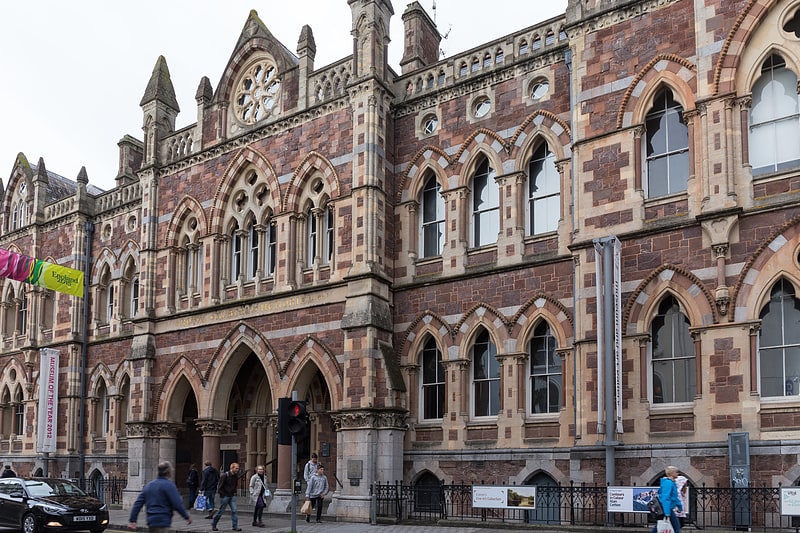
Museum in Exeter, England. Royal Albert Memorial Museum & Art Gallery is a museum and art gallery in Exeter, Devon, the largest in the city. It holds significant and diverse collections in areas such as zoology, anthropology, fine art, local and overseas archaeology, and geology. Altogether the museum holds over one million objects, of which a small percentage is on permanent public display. It is a 'Major Partner Museum' under the Arts Council England administered programme of strategic investment, which means RAMM receives funding to develop its services. RAMM receives this funding in partnership with Plymouth City Museum & Art Gallery. Previously they were described as 'hub museums' under the 'Renaissance' Programme for regional museums which operated between 2002–11 and funded by the now defunct Museums Libraries & Archives Council.
Founded in 1868, the museum is housed in a Gothic Revival building of local New Red Sandstone that has undergone several extensions during its history; most recently, the museum was re-opened on 15 December 2011 after a redevelopment lasting four years and costing £24M. Since its re-opening the museum has received several awards.[1]
Address: Queen St, EX4 3RX Exeter
Exeter Cathedral
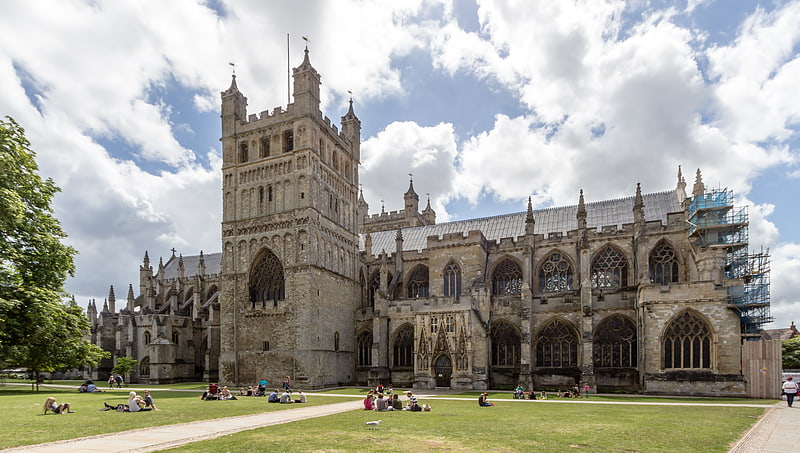
Gothic edifice with rooftop tours. Exeter Cathedral, properly known as the Cathedral Church of Saint Peter in Exeter, is an Anglican cathedral, and the seat of the Bishop of Exeter, in the city of Exeter, Devon, in South West England. The present building was complete by about 1400, and has several notable features, including an early set of misericords, an astronomical clock and the longest uninterrupted medieval stone vaulted ceiling in the world.[2]
Address: The Cloisters, EX1 1HS Exeter
Powderham Castle

Building in England. Powderham Castle is a fortified manor house situated within the parish and former manor of Powderham, within the former hundred of Exminster, Devon, about 6 miles south of the city of Exeter and 1⁄4 mile north-east of the village of Kenton, where the main public entrance gates are located. It is a Grade I listed building. The park and gardens are Grade II* listed in the National Register of Historic Parks and Gardens.
It is situated on flat, formerly marshy ground on the west bank of the River Exe estuary where it is joined by its tributary the River Kenn. On the opposite side of the Exe is the small village of Lympstone. Starting with a structure built sometime after 1390, the present castle was expanded and altered extensively in the 18th and 19th centuries. The castle remains the seat of the Courtenay family, Earls of Devon.[3]
Address: Powderham Castle, EX6 8JQ Kenton
Exeter Racecourse
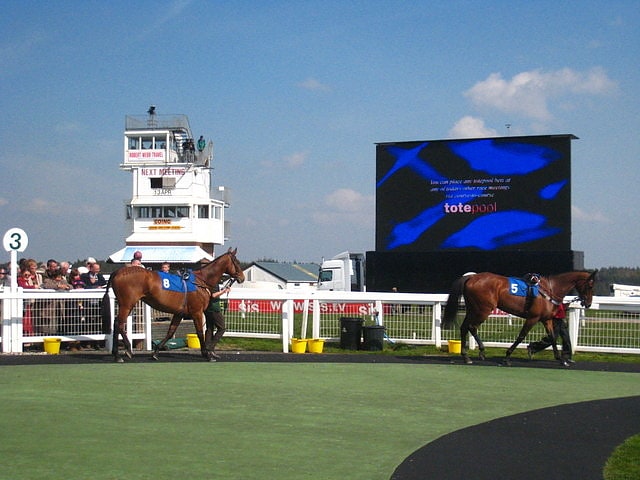
Sports venue in England. Exeter Racecourse is a thoroughbred horse racing venue located near the city of Exeter, Devon, England. Locally it is known as Haldon racecourse because of its location on top of the Haldon Hills. Until the early 1990s it was officially known as Devon and Exeter.
On 1 November 2005 racehorse Best Mate died at the course of a suspected heart attack whilst competing in the William Hill Haldon Gold Cup.[4]
Devon County War Memorial
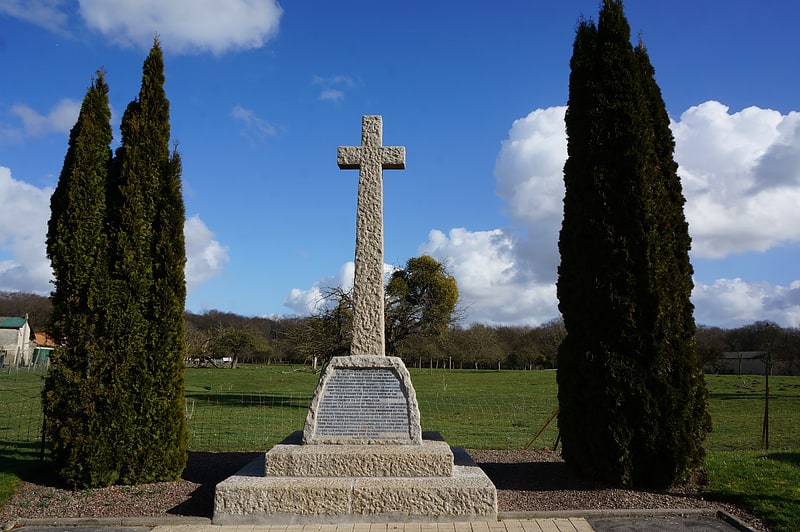
The Devon County War Memorial is a First World War memorial, designed by Sir Edwin Lutyens and situated on Cathedral Green in Exeter, the county town of Devon, in the south west of England. It is one of fifteen War Crosses designed by Lutyens with similar characteristics, and one of two to serve as a civic memorial in a city. The first proposal for the county's war memorial was to complete the construction of a cloister at Exeter Cathedral to be dedicated to Devon's war dead, but this scheme was abandoned due to lack of funds. After considering multiple proposals, the Devon County War Memorial Committee commissioned Lutyens to design a War Cross instead. The committee chose to site the memorial on the green of Exeter Cathedral after scouting several locations. A war memorial for Exeter itself was being considered concurrently, but the committees for the two projects failed to work together, resulting in two separate memorials—the county memorial by the cathedral and Exeter City War Memorial in Northernhay Gardens.
The memorial takes the form of a simple cross. Hewn from a single block of granite quarried from Haytor on Dartmoor, it stands just to the west of the cathedral, in alignment with the altar. The cross stands on a granite plinth, which itself sits on three steps. It was unveiled by the Prince of Wales on 16 May 1921. After archaeological excavations took place in the 1970s, the area was remodelled to create a processional way between the memorial and the cathedral. The memorial is a grade II* listed building, part of a "national collection" of Lutyens' war memorials. Since 2015, all of Lutyens' memorials in England have been protected by listed building status.[5]
St Mary Steps
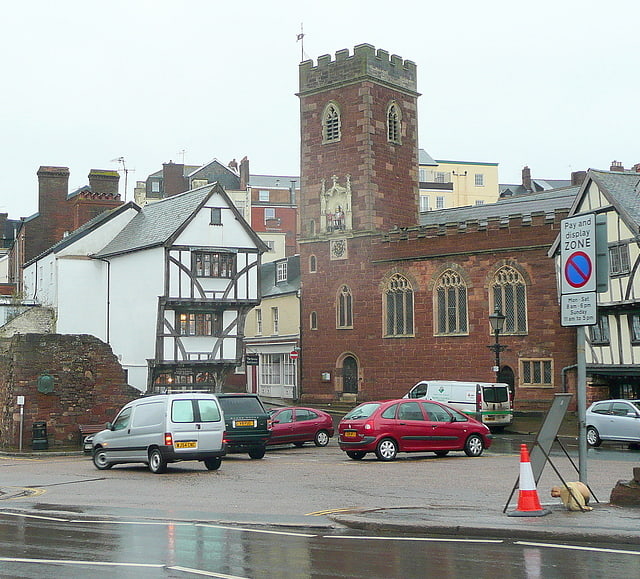
The Church of St Mary Steps is a Grade I Listed church in the city of Exeter, England.[6]
Sandy Park

Stadium in Exeter, England. Sandy Park is a rugby union stadium and conference and banqueting centre in Exeter, England. It is the home ground of Exeter Chiefs, who from the 2010–11 season have been playing in the Gallagher Premiership, the top flight of the English rugby union league system. The club relocated there from their former stadium at the County Ground in 2006. The stadium can hold 12,800 spectators and is located adjacent to M5 junction 30, which is around 5 miles from Exeter City Centre.
Sandy Park played host to the England Saxons vs Ireland Wolfhounds on 28 January 2012; the England Saxons won 23–17.[7]
Address: Exeter, Sandy Park Way, Exeter, Devon EX2 7NN, United Kingdom
Killerton
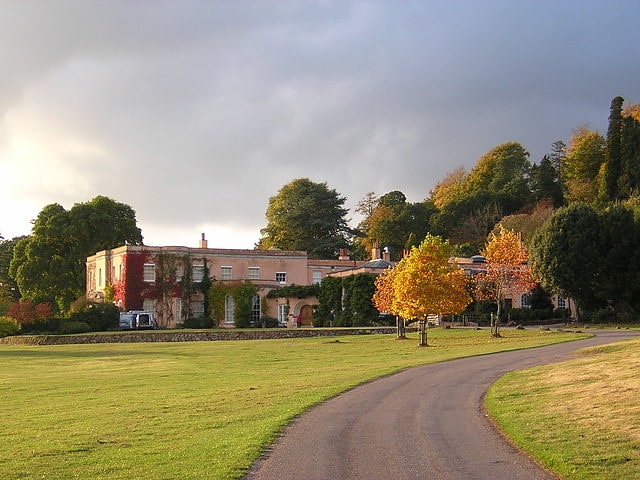
Building in England. Killerton is an 18th-century house in Broadclyst, Exeter, Devon, England, which, with its hillside garden and estate, has been owned by the National Trust since 1944 and is open to the public. The National Trust displays the house as a comfortable home. On display in the house is a collection of 18th- to 20th-century costumes, originally known as the Paulise de Bush collection, shown in period rooms.
The estate covers some 2590 hectares (25.9 km2, 6400 acres). Included in the Estate is a steep wooded hillside with the remains of an Iron Age Hill fort on top of it, also known as Dolbury, which has also yielded evidence of Roman occupation, thought to be a possible fort or marching camp within the Hill fort.
Killerton House itself and the Bear's Hut summerhouse in the grounds are Grade II* listed buildings. The gardens are Grade II* listed in the National Register of Historic Parks and Gardens.[8]
Address: Killerton House, EX5 3LE Exeter
Custom House
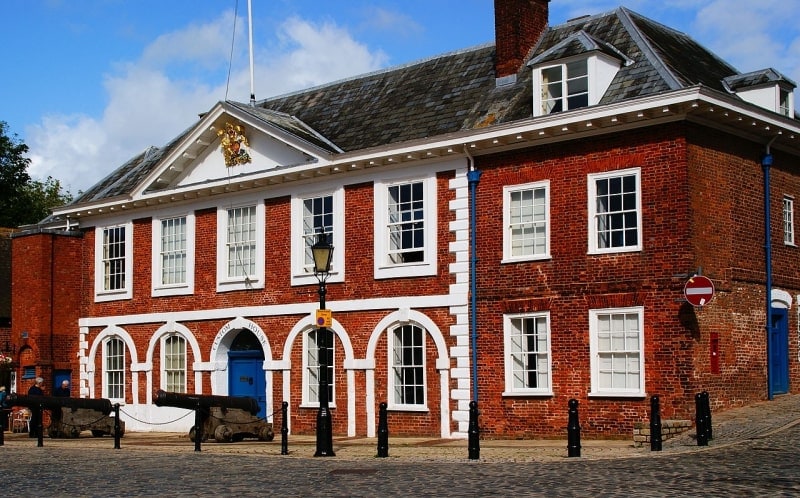
This Custom House at Exeter was the first in England built for that purpose. It was operated by HM Customs until 1989. Like other former custom houses in the United Kingdom, it now serves as a visitor attraction. It was built in the early 17th-century and has been Grade I listed since 1953.[9]
Redvers Buller
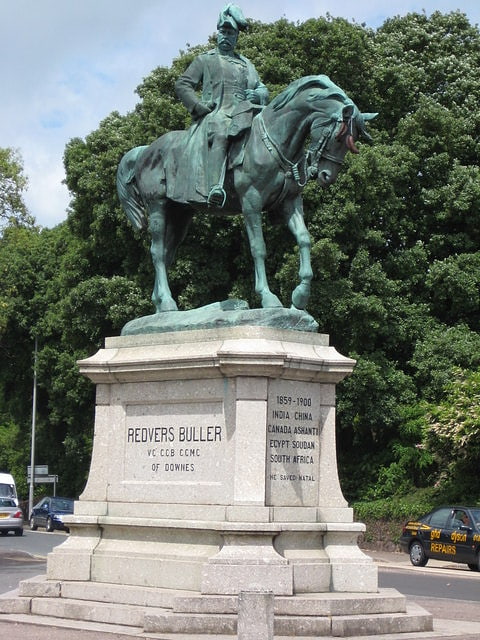
Statue by Adrian Jones. An equestrian statue of General Sir Redvers Buller stands at the junction of Hele Road and New North Road, close to Exeter College, Exeter, between St David's Church, Exeter and Bury Meadow Park. It was unveiled in 1905, and the bronze statue is mounted on a plinth of Cornish granite. It became a Grade II listed building in 1953.[10]
Exeter War Memorial

Exeter War Memorial, also known as The Northernhay War Memorial is a war memorial in Northernhay Gardens in the city of Exeter, Devon. Designed by John Angel, it was erected by public subscription in 1923 and cost over £6,000.[11]
Cricklepit Mill
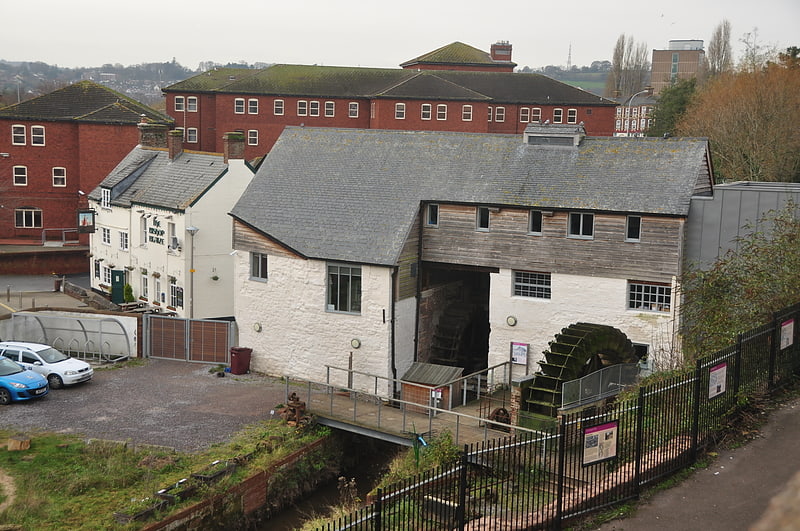
Cricklepit Mill is a visitor centre of the Devon Wildlife Trust, located in Exeter, in Devon, England.
It is one of three visitor centres of the Trust; the others are Wembury Marine Centre near Plymouth, and Seaton Jurassic in Seaton.[12]
Address: Commercial Road, EX2 4AB Exeter
St Stephen's Church
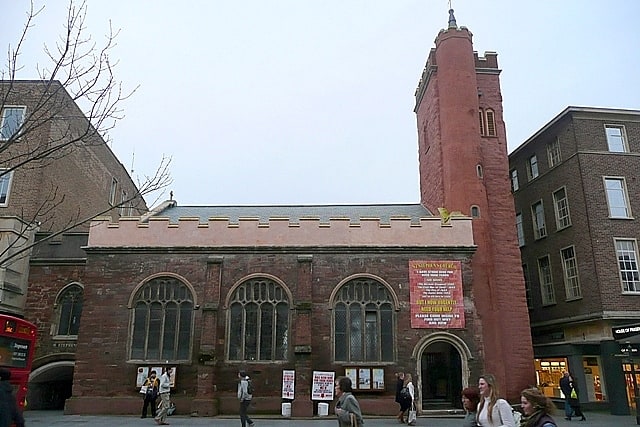
Anglican church in Exeter, England. St Stephen's Church is a small church in the centre of Exeter. It has a Saxon crypt but the first mention of the church is in the Domesday Book. Its location was formerly opposite the medieval guildhall. In July 2012 it reopened following a major renovation which cost £1.5 million.[13]
Address: 29 High St, EX 1 1 Exeter
St Olave's Church
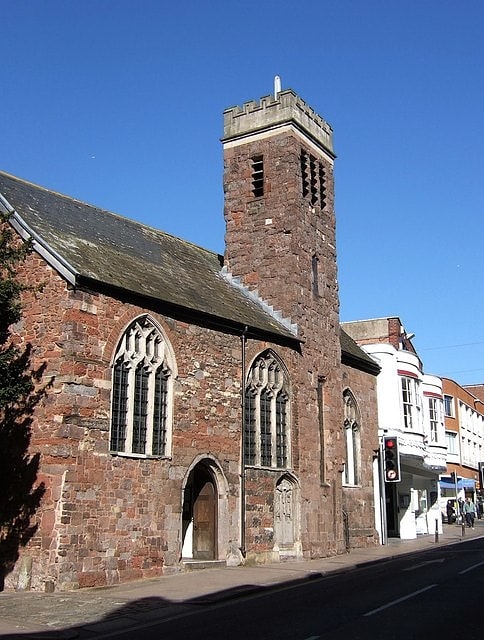
Anglican church in Exeter, England. St Olave's Church is a small church which was founded in 1053 by Lady Gytha, the mother of King Harold. The church is dedicated to Saint Olaf, a Viking king who converted to Christianity. It was rebuilt in the late 14th century.[14]
Rougemont Castle
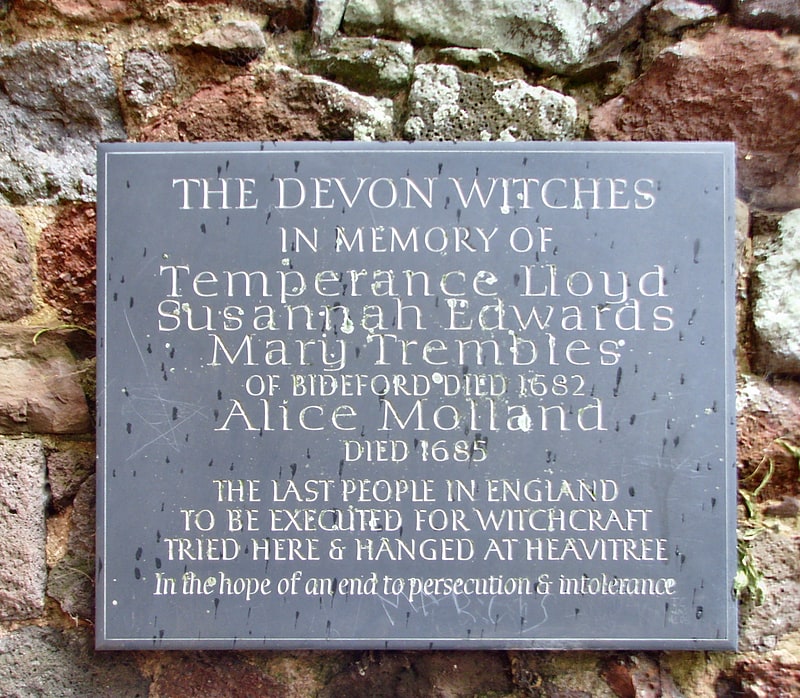
Wedding venue in Exeter, England. Rougemont Castle, also known as Exeter Castle, is the historic castle of the city of Exeter, Devon, England. It was built into the northern corner of the Roman city walls starting in or shortly after the year 1068, following Exeter's rebellion against William the Conqueror. In 1136 it was besieged for three months by King Stephen. An outer bailey, of which little now remains, was added later in the 12th century.
The castle is mentioned in Shakespeare's play Richard III in a reference to that king's visit to Exeter in 1483. Devon's county court was located here from at least 1607, and the three Devon Witches—the last people in England to be executed for witchcraft—were tried and convicted at the Exeter Assizes in 1682.
All the buildings inside the walls were swept away in the 1770s to make way for a new courthouse, which was extended by the addition of wings in 1895 and 1905. Because of its function as a court, the interior of the castle was not open to the public until the court moved to a new site in 2004. The entire site was later sold to a developer whose stated aim was to transform it into "the Covent Garden of the South West".
The castle is named after the red stone found in the hill, and used in the construction of the original buildings, of which the large early Norman gatehouse is the main remaining feature. It is surrounded on three sides by the Rougemont Gardens and Northernhay Gardens, public parks now maintained by Exeter City Council.[15]
Address: Castle St, EX4 3PT Exeter
Northernhay Gardens
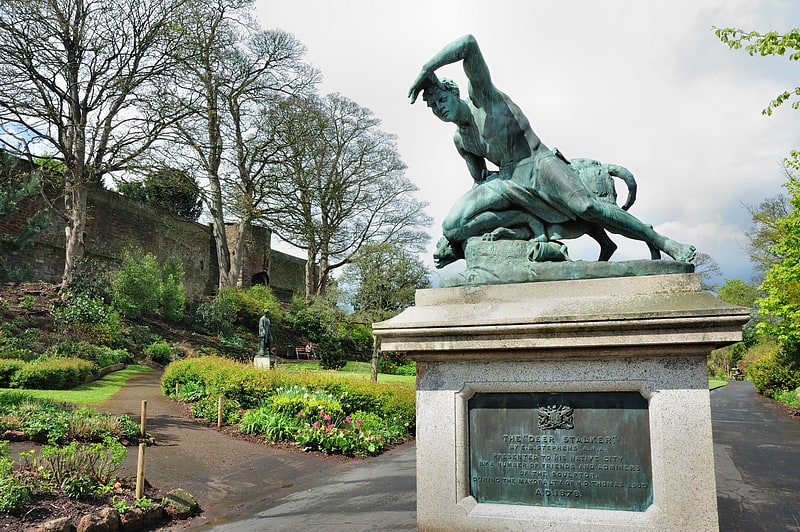
Park in Exeter, England. Northernhay Gardens are located in Exeter, Devon, England, on the northern side of Rougemont Castle. They are the oldest public open space in England, being originally laid out in 1612 as a pleasure walk for Exeter residents. The gardens are Grade II listed in the National Register of Historic Parks and Gardens, and are maintained by Exeter City Council.
The site was originally quarried in Roman times for stone for the city walls. The gardens incorporate a stretch of Roman wall and the only length of Saxon town wall to be seen in England. They form a crescent shape bounded to the north by the West of England Main Line and Exeter Central railway station, and to the south by the castle and Rougemont Gardens. Their eastern entrance is at the head of Northernhay Place and the gardens open on the west to Northernhay Gate.
The early park was destroyed in the Civil War, in 1642, when large defensive ditches were dug outside the walls for the city's defence. Soon after the Restoration, in 1664, the city set about restoring the park, planting hundreds of young elms and laying out gravel paths. There has been a tradition of maintaining the park as a major city amenity since that time.
The gardens underwent a major re-landscaping in 1860, and between 1860 and 1895 received an important group of monuments to major Victorian figures in the city's history. The Deer Stalker (1875) by E. B. Stephens (1815–1882), is a significant piece of Victorian art that was exhibited at the Royal Academy in 1876. Stephens also sculpted the statues of John Dinham, who was a local philanthropist, and Sir Thomas Dyke Acland, 10th Baronet, in the gardens.
In the 17th and 18th centuries Northernhay Gardens were affectionately known by the familiar name "Norney".
The statue of the Conservative politician Stafford Northcote (1887) is by Joseph Boehm. The Volunteer Memorial (1895), designed by S. K. Greenslade, commemorates the formation of the 1st Rifle Volunteers in 1852, and the Exeter War Memorial by local sculptor John Angel was constructed in 1923. The gardens also contain a bandstand.
In the mid 1900s the mature avenue of elms lining the central walk succumbed to Dutch Elm Disease and were felled. Subsequent planting has sought to provide all-year-round colour and interest. The gardens offer views over large parts of the city, and events are hosted there throughout the year.[16]
Address: Northernhay Place, EX4 3QE Exeter
St Nicholas Priory
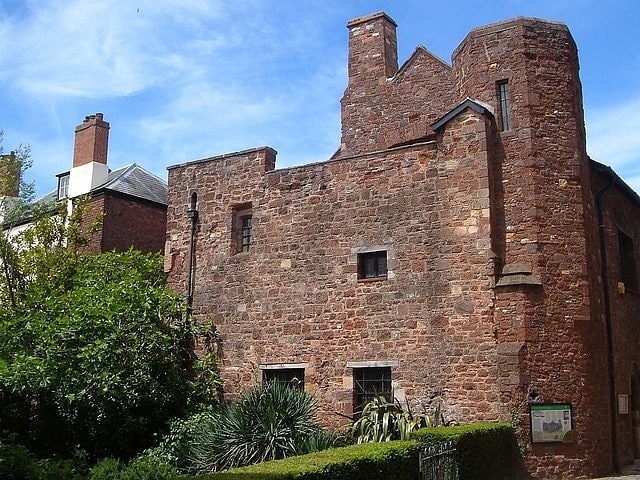
Museum in Exeter, England. The Benedictine Priory of St Nicholas or just St Nicholas Priory was a Benedictine monastery founded in Exeter, England, in 1087. At the Dissolution of the Monasteries the church and chapter house range were pulled down but the domestic buildings were left intact. Parts of the north and west ranges of the monastery survive with the west range now being a museum owned by Exeter Historic Buildings Trust.[17]
Address: The Mint, EX4 3BL Exeter
Fingle Bridge

Arch bridge in England. Fingle Bridge is a 17th-century stone arch bridge carrying an unclassified road over the River Teign near Drewsteignton, within Dartmoor National Park in Devon, England. This packhorse bridge has three arches and the two central piers are surrounded by triangular cutwaters extending upwards to form pedestrian refuges, and is a Grade II* listed building.[18]
Address: Drewsteignton, Exeter EX6 6PW, Exeter
St Martin's Church
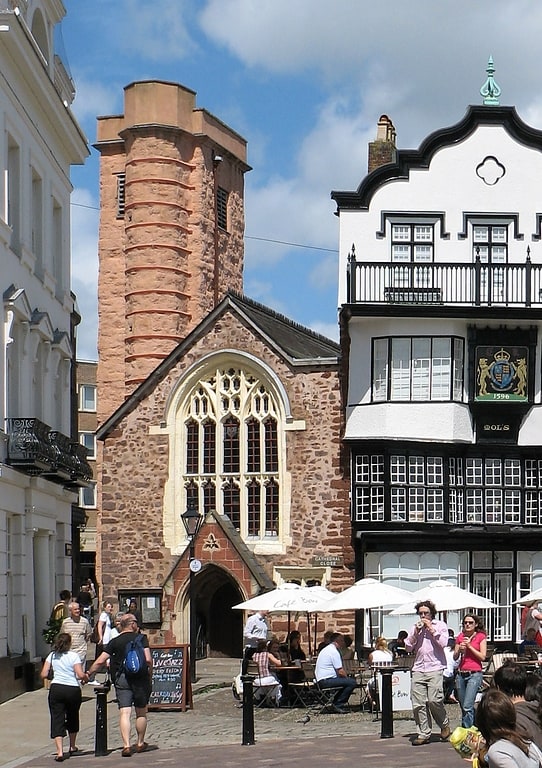
Building in Exeter, England. St Martin's Church in Cathedral Close, Exeter, Devon, England was built in the 15th century. It is recorded in the National Heritage List for England as a designated Grade I listed building, and is now a redundant church in the care of the Churches Conservation Trust. It was vested in the Trust on 1 August 1995.
It is built of Heavitree stone and has slate roofs. The chancel arch is thought to be the oldest part of the building, and may date from the previous church on the site which was consecrated on 6 July 1065 by Bishop Leofric. There are traces of Anglo-Saxon long-and-short work high in the north-east corner of the nave. The tower was added in 1675.
The interior contains 17th and 18th century monuments, reredos and altar rails, some of which were brought from the nearby St Paul's, which was demolished in 1936. The south window contains a few fragments of medieval glass. At the west end is a panelled gallery with the painted arms of Bishop Trelawny (1688—1707) and the City of Exeter, both flanking the royal coat of arms.[19]
Address: Cathedral Close, EX1 1EZ Exeter
Guildhall
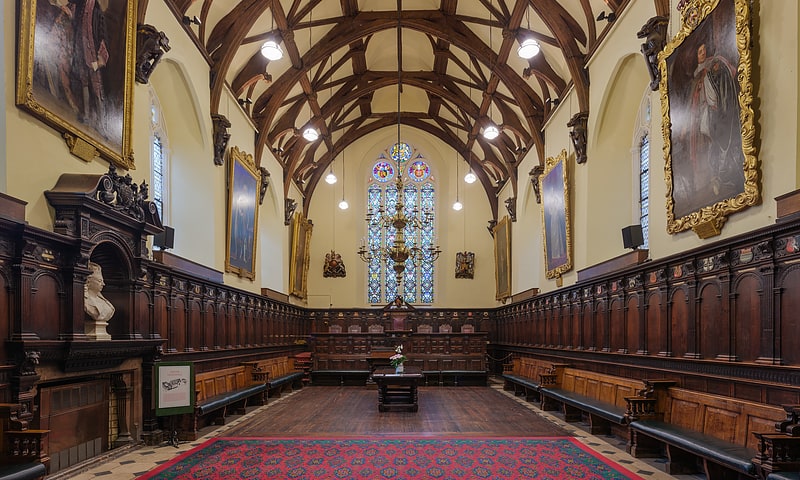
Monument in Exeter, England. Exeter Guildhall on the High Street of Exeter, Devon, England has been the centre of civic government for the city for at least 600 years. Much of the fabric of the building is medieval, though the elaborate frontage was added in the 1590s and the interior was extensively restored in the 19th century. It is a Grade I listed building.[20]
Address: High St., Exeter
St Michael and All Angels Church
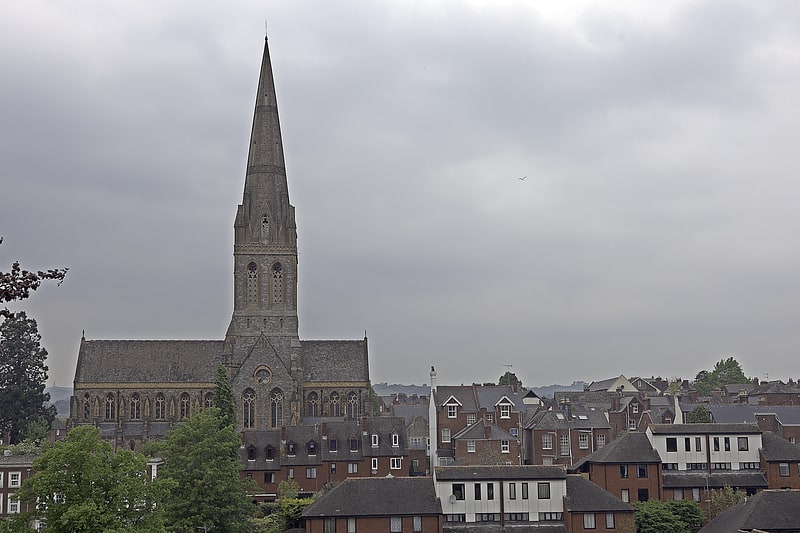
Anglican church in Exeter, England. St Michael and All Angels Church, on Mount Dinham in Exeter is an Anglican church in Devon, England. It is a Grade I listed building. The church is Anglo-Catholic in tradition. The building in is the early Gothic style and was built to the designs of Major Rohde Hawkins, 1867–68. The reredos is by W. D. Caroe, 1899.
Within the Parish of St David with St Michael and All Angels, the building towers above its surroundings, the spire exceeding the height of even the towers of Exeter Cathedral.[21]
Address: Mount Dinham, Exeter
Haldon Forest

Haldon Forest is a forest located in the Haldon Hills, Devon, England. The forest consists of several different woods. Geographically, Haldon Forest is located between the towns of Chudleigh and Exminster and is south of Exeter.[22]
Address: Haldon Forest Park Bullers Hill, EX6 7XR Exeter
Rougemont Gardens
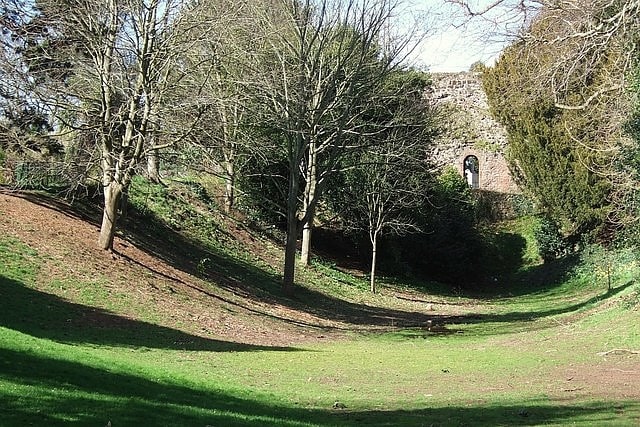
Garden in Exeter, England. Rougemont Gardens is an ornamental open space adjacent to Rougemont Castle in the city of Exeter, Devon, England. It is Grade II listed in the National Register of Historic Parks and Gardens. Originally part of the defences of the castle, it was converted into a garden in the late 18th century, and purchased by the city council in 1912.[23]
The Turf
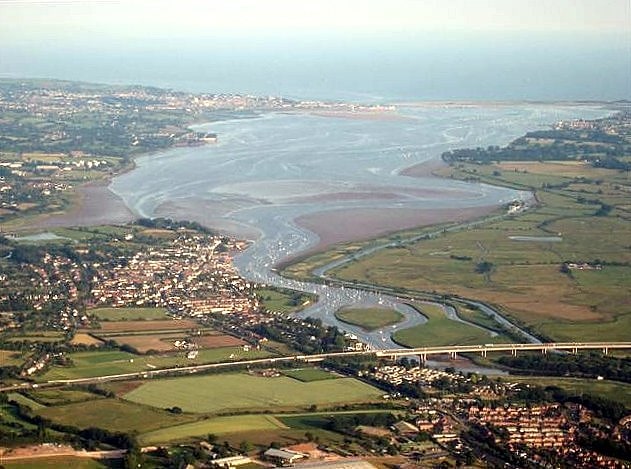
Canal in the United Kingdom. The Exeter Ship Canal, also known as the Exeter Canal is a canal leading from the River Exe to Exeter Quay in the city of Exeter, Devon, England. It was first constructed in the 1560s predating the "canal mania" period and is one of the oldest artificial waterways in the UK.[24]
Address: Exeter Canal, Exeter
St Pancras Church
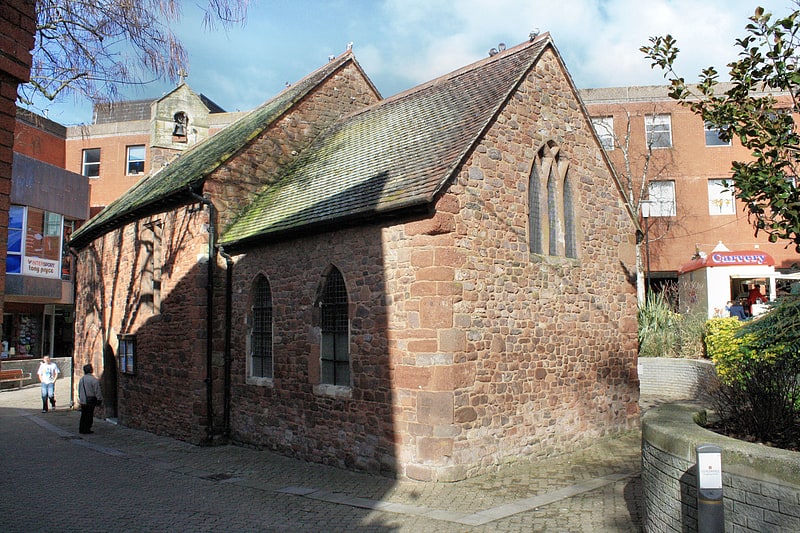
Anglican church in Exeter, England. St Pancras Church is a small church situated in the middle of the Guildhall Shopping Centre in Exeter. The majority of the church dates from the thirteenth century, although the font is eleventh century. The church probably occupies the oldest Christian site in Exeter, and is usually open on weekdays. The church is designated by English Heritage as a Grade II* listed building.[25]
Spacex Art Gallery

Arts organization in Exeter, England. Spacex was a contemporary art organisation, located in Exeter, between 1974 and 2017. It was founded in 1974 by John Butler as an artist co-operative. Its programme spanned installations, performance, photography, sculpture, painting, film and video. Its learning programme focused on helping visitors of all ages to explore and engage with contemporary art.
Spacex ceased activity at the end of 2017 with the formal closure of the charity.[26]
Address: 45 Preston Street, EX1 1DF Exeter
Devon County Council
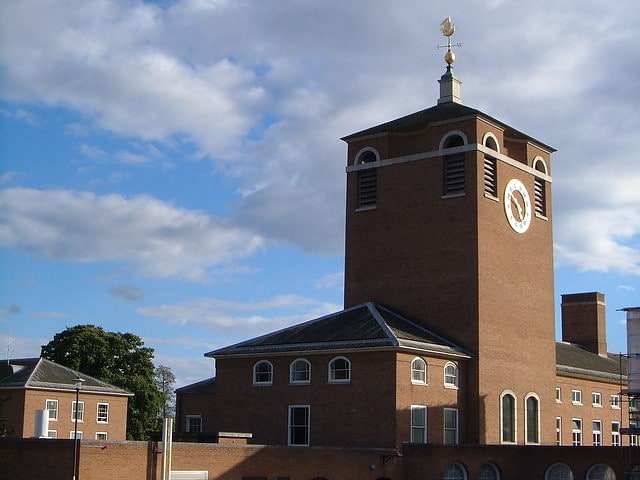
Devon County Council is the county council administering the English county of Devon. Based in the city of Exeter, the council covers the non-metropolitan county area of Devon. Members of the council are elected every four years to represent the electorate of each county division, almost all being nominated by the major national political parties.
The population of the area administered by the council was estimated at 795,286 in 2018, making it the largest local authority in South West England.
Devon is an area with "two-tier" local government, meaning that the county is divided into non-metropolitan districts carrying out less strategic functions, such as taking most planning decisions. In Devon there are eight such districts, each with its own district, borough, or city council.[27]
Mary Harris Memorial Chapel of the Holy Trinity
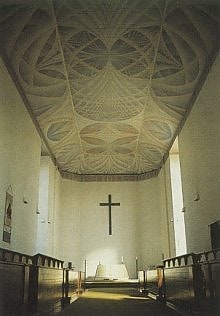
Anglican church in Exeter, England. The Mary Harris Memorial Chapel of the Holy Trinity is the Anglican Chaplaincy's chapel on the Streatham Campus of the University of Exeter. It is located at the heart of the campus, beneath Queen's Building and adjacent to the Old Library and the Roborough Building.
The chapel is served by the Lazenby Chaplain who is assisted in the chapel's worship life by a team of servers and the University Chapel Choir.[28]
Exeter Mosque
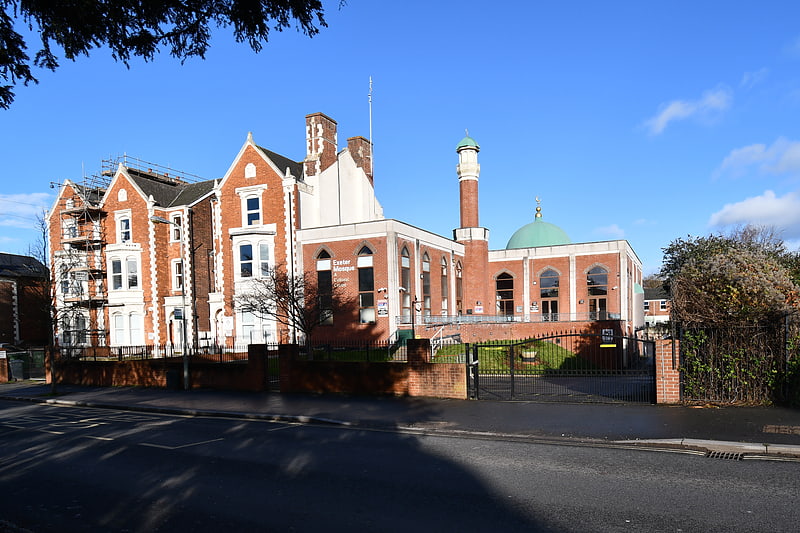
Exeter Mosque & Cultural Centre is a mosque in the City of Exeter, in Devon, England.[29]
Barnfield Theatre
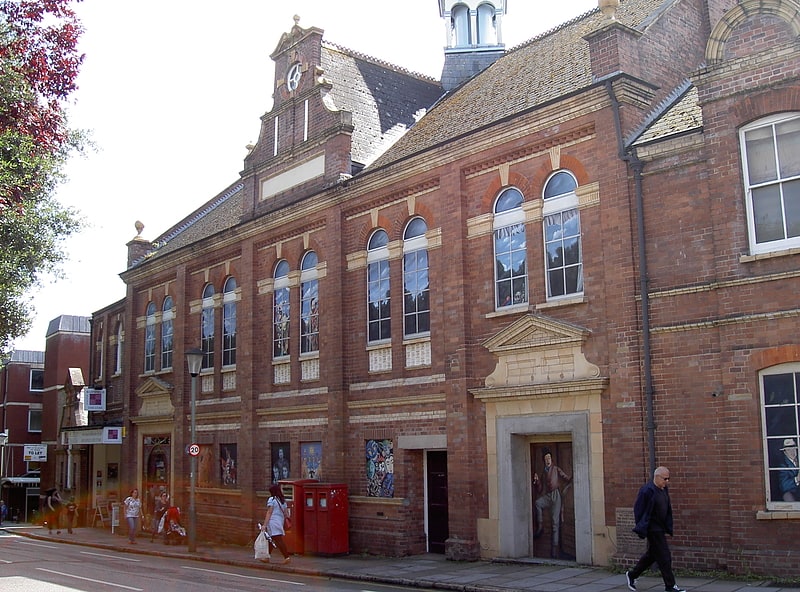
Theatre in Exeter, England. The Barnfield Theatre is a theatre in Exeter, England, located near the centre of the city on Barnfield Road, Southernhay. It was originally built as the Barnfield Hall near the end of the 19th century by Exeter Literary Society, and was converted to a theatre in 1972.
Today the theatre is operated as a charity and is used as a venue for amateur and professional theatrical companies. The building is owned by Exeter City Council and was leased to Barnfield Theatre Limited, who ran the theatre until December 2021, when its management was taken over by the Northcott Theatre.[30]
Address: Barnfield Road, EX1 1SN Exeter
Northcott Theatre

Theatre in Exeter, England. The Northcott Theatre is a theatre situated on the Streatham Campus of the University of Exeter, Exeter, Devon, England. It opened in 1967 and was run until 2010 by the Northcott Theatre Foundation, when the company ceased operating after a period in administration. The theatre is now known as Exeter Northcott Theatre and became a registered charity in June 2013.[31]
Address: Stocker Road, EX4 4QB Exeter
St Petrock's Church
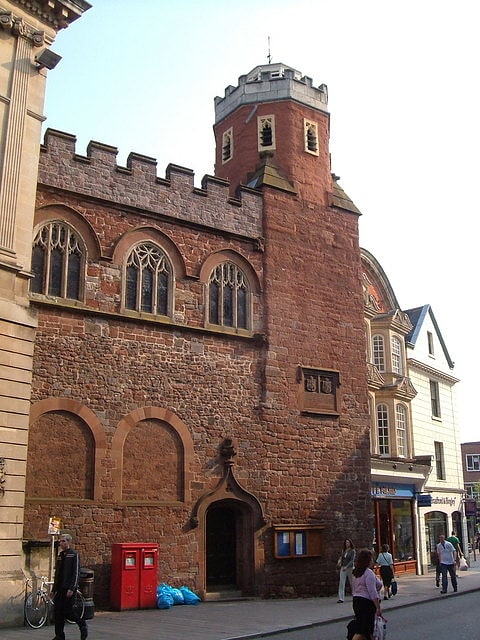
St Petrock's Church is a small church in the centre of Exeter with an interior described by Nicholas Pevsner as "among the most confusing of any church.. in England". The church may have been founded as early as the 6th century, but other sources date it to the 11th century. William the Conqueror directed the City Provost to pay it one silver penny out of the public taxes, along with 29 other churches. The current building dates originally from early medieval times and is dedicated to St Petrock, who was a 6th-century Roman Catholic Welsh abbot who was later granted the title of saint by the Vatican.[32]
Address: 10 Cathedral Yard, Exeter
Belmont Park

Park in Exeter, England. Belmont Park is a public park in Exeter, England. Opened to the public in 1886 as a children's play area, it was subsequently enlarged for the use of the general public.[33]
Exeter Quay

Exeter Quay, also known as Exeter Quayside, is a part of the city of Exeter next to the River Exe and the Exeter Ship Canal. It was first used as a port in prehistoric times when a sandstone ledge was used to unload the ships of overseas traders. However, by 1381 the Countess Weir had blocked the river to shipping. In 1566 a canal was completed to provide access for ships. Over time the number of ships using the quayside increased and so the quay was expanded in the late 17th century. Further expansion occurred in 1830 when a new canal basin was dug. However, in 1840 the railways reached Exeter and the shipping began to decline. No longer used for shipping, the quayside is now mostly used for leisure included in the links below.
A manually operated cable ferry known as the Butts Ferry crosses the Exe at Exeter Quayside.[34]
Address: Haven Road, Exeter
St Mary Arches Church
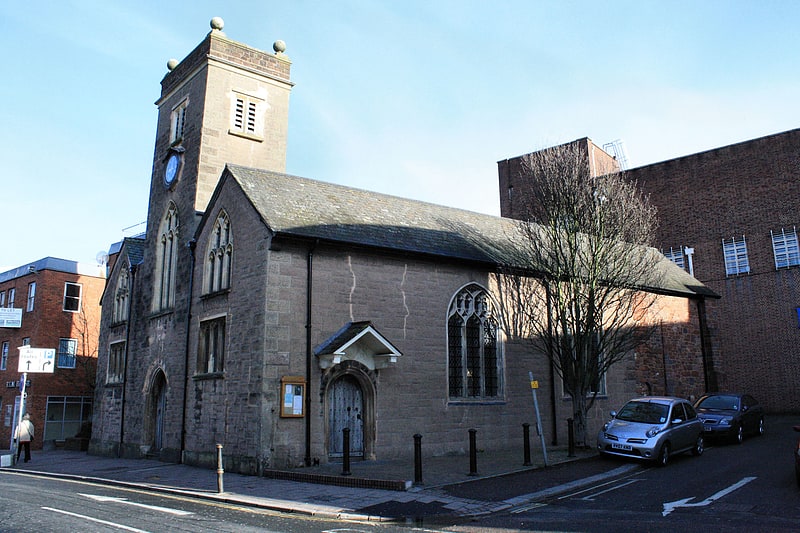
Anglican church in Exeter, England. St Mary Arches Church is a small church in Exeter, Devon, England, which retains many Norman features. It was a place of worship for the Mayor of Exeter and local merchants during the 14th, 15th and 16th centuries. The Arches part of the name may come from a medieval arched thoroughfare which was located next to the church.
The church is largely made of red sandstone and is listed as Grade I by Historic England.[35]
Address: Mary Arches Street, Exeter